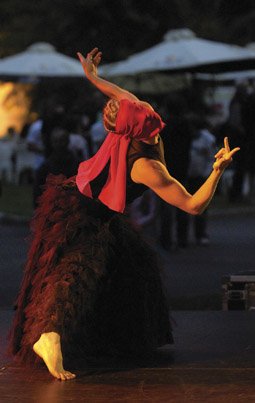rhyme and reason
ashley syne: tasdance's one for sorrow, two for joy

One for sorrow, Two for joy, Tasdance
photo Paul Scambler
One for sorrow, Two for joy, Tasdance
IN RAEWYN HILL’S ONE FOR SORROW, A FACELESS WOMAN IS HIDDEN BENEATH A BLOOD-RED SCARF. THE WARM LIGHT FROM ABOVE CREATES SHADOWS, ACCENTUATING HER FINE FEATURES. MOMENTARILY LIKE A STATUE, THE DANCER WAITS BEFORE MERGING INTO AND OUT OF THE VERTICAL OBLONG OF LIGHT CENTRESTAGE. SHE WALTZES BLITHELY, WITH MORE THAN A SUGGESTION OF POIGNANCY, HER LIMBS EXTENDED AND RELEASED FROM BENEATH A FULLY-FRILLED BLACK LACE DRESS.
One for Sorrow, Two for Joy is an exhilarating, fascinating and entertaining night of multi-faceted, eclectic dance from the dynamic Tasdance ensemble. Six lines from the rhyme One for Sorrow provide the theme for six short works that exhibit a unique array of contemporary dance styles ranging from the robustly physical to the adroitly lyrical and naff, maturely and vigorously performed.
One for Sorrow is a solo taken from Hill’s full-length Mercy: A dance for the forgotten [www.realtimearts.net/feature/search/8457]. Dancer Floeur Adler tells a story of loss, grief and sadness, her lone body speaking of the past as her veiled face holds secrets deeply concealed. Hues of black and red conjure images of death and violence, but these are juxtaposed with the unreservedly graceful innocence and delicacy of Adler’s movement. Her brief solo ends almost as soon as it begins.
Two for Joy, choreographed by Trisha Dunn follows. The box of light shifts horizontally, a trance-like score pounds heavily, two male dancers clad in half silver, half black animate the space with high-energy, acrobatic shoulder-stands and asymmetrical balances. Joyful in their execution, the dancers suggest brotherly bonding as they playfully wrestle, tumble and support one another, tipping and almost toppling over the obstacles each presents the other. Alive, awake, aware, Malcolm McMillan and James Shannon perform with animal instinct and precision. They finish, breathing heavily, shattered.
McMillan, choreographer of Three for a girl, creates a sweet, picturesque tribute to choreographer Trisha Dunn through lyrical movement. The placid articulation of arms, quaint positions of feet and silky motion of the torsos of the three female dancers create a perpetual wave of exquisite detail and fleeting subtleties. The score of piano and harpsichord acts as a catalyst for the fluid sweeping and arching of bodies.
In Anna Smith’s Four for a boy, fingers flex and bend, grotesque in their twists; shoulders rotate like wings and spines torque. Recalled images of ADT’s Devolution flood in as the score creaks mechanically, heavy and frightening. Smith explores physicality and power through both male and female forms. The quartet of dancers are in knee pads. The women are in ultra girlie sunflower-yellow dresses, their faces full of life yet bodies dehumanised, machine-like. Raw and gutsy, they execute the intricate and erratic style of Smith’s choreography, the sounds mirrored in their bodies. With their cleverly structured lifts, spontaneous counter-balances, the risky and fearless dancers are thrilling to watch.
Smith worked with costume designer Greg Clarke to create Five for silver, a visually astounding work. An extravagant, fantastical landscape is formed from bodies amid a sea of silvery-blue, a watery sheath of dreams. This over-sized mass of metallic fabric, with an aperture for each dancer, allows the dancers to intermittently amalgamate and disperse. Detached and concurrently connected by this oceanic costume, torsos sway, coil and undulate in sync amidst the seemingly infinite waves of material.The dancers shift clockwise, a carousel. Legless bodies rotate, fluid and lyrical, creating spirals of shadowed creases, dark velvety crevasses beneath the moon-lit surface. The structure is broken an unexpectedly tender, amorous embrace in a male-female duet.
Six for gold, choreographed by Natalie Cursio and inspired by the television show Solid Gold, parodies the auditions, documentaries and grand finales of outdated TV dance competitions. Daft gold bull masks, numbered leotards and tights along with eisteddfod-style dance moves and exaggerated re-enactments make up this outrageously hilarious work. The hour is up, the night has flown, and the ambiguity of the phrase ‘”Seven for a story never been told” hovers.
Tasdance, One for sorrow, Two for joy, choreographers Natalie Cursio, Trisha Dunn, Raewyn Hill, Malcolm McMillan, Anna Smith, performers Floeur Alder, Carlie Angel, Malcolm McMillan, James Shannon, Trish Wood, design for Five for silver Greg Clarke, lighting Darren Willmott, Parramatta Riverside Theatre, Sydney, Oct 29–Nov 1
RealTime issue #88 Dec-Jan 2008 pg. online






